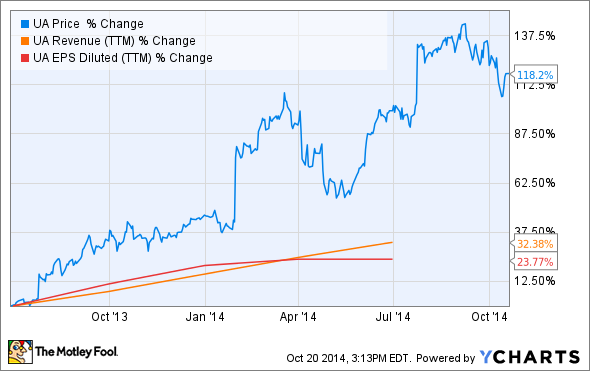Athletic-apparel maker Under Armour (UAA -2.70%) has been on an incredible run of growth for the past several years, and the market has responded with resounding support. Over the past 12 months' earnings announcements, Under Armour's sales and earnings per share have grown 32% and 23%, respectively, but the stock price has absolutely left that strong performance in the dust:
But before you think this is a prediction of imminent doom for the stock -- it isn't -- it's important for investors to see just how far, and how quickly, the stock has run on some really solid performance.
Past performance is great, but let's keep looking forward. Here are three things to look for from this week's earnings report that will help us understand whether Under Armour's growth plans are continuing to bear fruit.
A quick look back
Last quarter, Under Armour raised its full-year revenue and operating income guidance, increasing both targets to almost 30% growth from the prior year. This was the second time the company had increased its guidance this year, having raised it after a blowout first quarter. Revenue was up 36% and 34% in the first two quarters, while earnings per share grew 71% in Q1. EPS was flat last quarter, because of increases in marketing and "innovation" (i.e., product development).
In short, growth continues to accelerate, and management is forecasting slightly lower than recent historical results. Sandbagging? Maybe, but better to be conservative with a less-than-stellar consumer economy in play. But if that growth is to continue, here are the three main drivers that you want to look for in this week's earnings.
1. Gotta be the shoes

Nike retained Kevin Durant, but Under Armour showed it can compete for top talent. Source: Nike.
While Under Armour has established itself as a player in high-performance athletic apparel, its shoe business is still minuscule. But because the company has established its brand so well, the opportunity to grow its footwear business is enormous. CEO Kevin Plank highlighted this point on the company's most recent earnings call, pointing out that the company had almost matched 2012's full-year footwear sales of $239 million in the first half of 2014, with $223 million.
How big can footwear be for Under Armour? It has accounted for less than 18% of sales so far this year. As a comparison, Nike, Inc.'s (NKE -0.98%) footwear business makes up more than 58% of total sales.
Maybe some folks are disappointed that Under Armour didn't land basketball superstar Kevin Durant in a sponsorship deal, but it's good that management didn't write the $350 million check that Nike will end up cutting to retain him. As Plank said in a recent interview, sales projections were the same with or without Durant, and Under Armour made it known throughout the sporting world that it can compete for the biggest talent.
What does this have to do with earnings? If footwear is growing at a faster rate than the consolidated business, that's a great thing. If growth slows, then maybe the company's efforts to establish itself in the shoe business need some more work.
2. Athletic women, not just female athletes
Will Gisele help drive brand awareness to a wider audience? Source: Under Armour.
While sponsoring female athletes is nothing new to sporting-goods manufacturers, Under Armour has taken it to a different level, with its hugely successful feature of ballerina Misty Copeland, whose story of defying the odds of success is as compelling as any in sport.
Adding to this success is the company's recent deal with supermodel Gisele Bundchen, which is clearly aimed at continuing to raise awareness of the brand to women outside the world of sport.
While Under Armour won't break women's apparel out in its earnings release, you can be sure the topic will get plenty of discussion in the company's earnings call. Plank referred to it on the most recent call as a "$500 million-plus business" for the company, making women's apparel larger than footwear. A company presentation backs this claim up, with women's apparel expected to be a $960 million business in 2016, while footwear will be $600 million. Listen to the earnings call for more detail on this business segment.
3. International growth kicking in
Under Armour is using the global popularity of soccer to expand. Source: Under Armour.
The international stage is a huge source of future growth, and from all of the Under Armour's product segments. While 54% of Nike's 2014 sales were from outside the U.S., only 6% of Under Armour's sales were international last year. That disparity -- combined with the fact that the global middle class will grow by 1 billion over the next 20 years -- is a strong indication just how important international sales will be to Under Armour's future.
The company is projecting that international sales will double in mix from last year's 5.9%, to 12% of total sales by 2016. Through the first half of 2014, international sales had already advanced to 8.9% of total sales. Look for this trend to keep accelerating.
Pricey stock, but a result of elite performance
With price-to-earnings and price-to-sales multiples practically double those of Nike, Under Armour is an "expensive" stock right now. However, the business is executing essentially in all of the key areas, and there is nothing to indicates that the trends will slow down anytime soon. After all, Under Armour is still less than one-tenth the size of Nike by sales, so even at double the price based on its price-to-sales ratio, there's still a lot of upside.
However, today's price and this week's earnings shouldn't be the major focus. As long as the company's growth continues to be strong, the market will probably keep paying a premium. Will the trend continue? If the company keeps executing on the things I've discussed here -- things we'll learn more about in a few days -- then the answer is most likely "yes."







